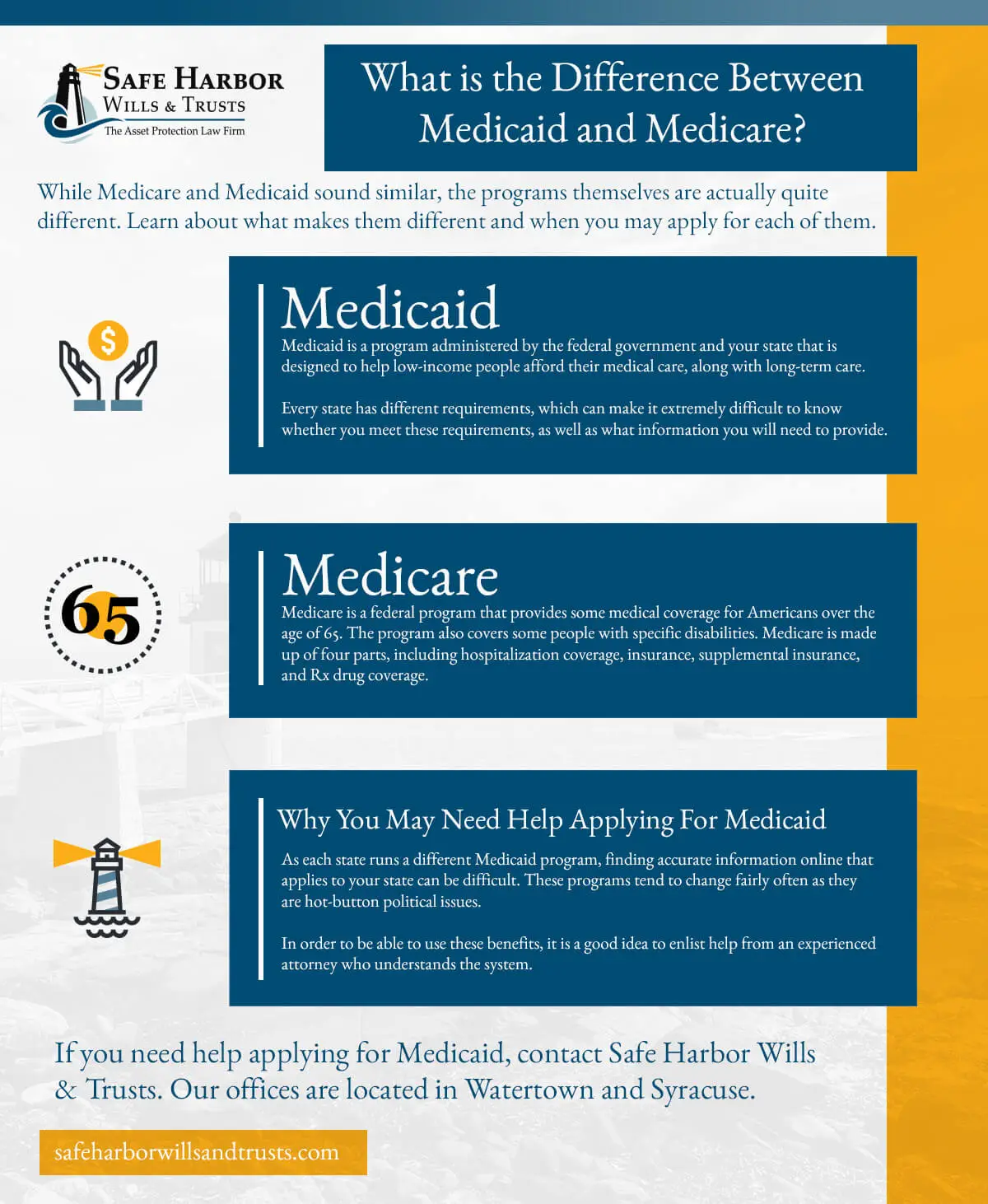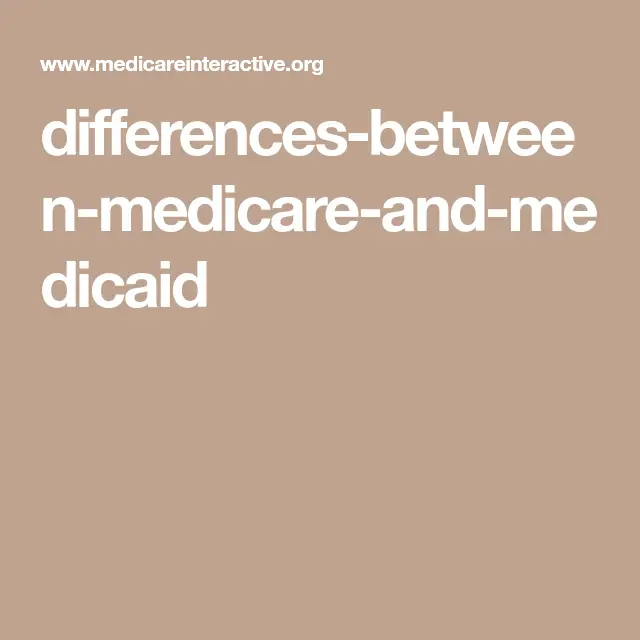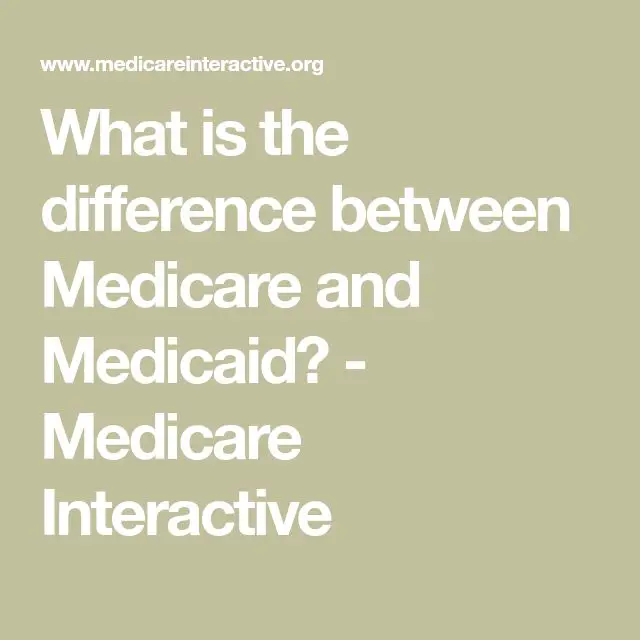What Is The Difference Between Medicare Vs Medicaid
Medicare and Medicaid are both government-sponsored health insurance programs designed to help cover healthcare costs for different populations:
- Medicare: Federal program that provides health coverage to people 65 and older or those under 65 disability regardless of income
- Medicaid: State and federal program that provides health coverage to people with very low income
While both Medicare and Medicaid are valuable programs, its important to understand the difference between the two.
Read Also: What Is The Penalty For Dropping Medicare Part D
What Is The Medicaid Waiver Program
Federal guidelines have provided an avenue for states to develop community-based services waivers to better meet the long-term care goals of individuals who prefer to seek care in their own community or home as opposed to a hospital or institutional setting. The waivers must target a specific group and states are able to operate as many waivers as they wish.
The Medicaid website outlines the four criteria for the waivers under federal guidelines. The waiver programs must:
- Demonstrate that providing waiver services wont cost more than providing these services in an institution.
- Ensure the protection of peoples health and welfare
- Provide adequate and reasonable provider standards to meet the needs of the target population
- Ensure that services follow an individualized and person-centered plan of care
Some of the services of care that are often covered under these waivers include case management, home health aides, adult day health services, personal care, and respite care. While these are the most common, states are able to propose other types of care that they believe will help individuals which is a unique feature of the waiver program. Essentially, these HCBS programs give states the ability to tailor resources to more specialized groups.
What Does Medicare Plan F Cover
Youll need to investigate the different Medigap plans to determine the right one for you. The comparison chart below will help.
Medicare Plan F provides the same healthcare coverage from state to state. In general, you can use it to cover the copayment for all medical costs and even the Medicare Part B deductible.
Another benefit covered by Plan F is Medicare Part B Excess ChargesA Medicare Part B excess charge is the difference between a health care providers actual charge and Medicares approved amount for payment.. These occur when your doctor or specialist does not accept the standard Medicare payment for a service. Medicare allows healthcare providers that do not accept Medicare assignmentAn agreement by your doctor to be paid directly by Medicare, to accept the payment amount Medicare approves for the service, and not to bill you for any more than the Medicare deductible and coinsurance. to charge up to 15 percent more. Without Plan F, you will pay these costs out-of-pocket.
Plan F also covers your big costs if you are admitted as an inpatient in the hospital or a skilled nursing facility. Your Medicare benefits cover these costs under Part A, but most people are taken by surprise when they see the per-benefit-period deductible. Plan F is one of these insurance plans that protect enrollees from these high out-of-pocket expenses.
Heres a side-by-side Medigap comparison chart:
You May Like: When Is Open Enrollment For Medicare
You May Like: Pediatric Dentist St Louis Medicaid
What Are My Coverage Options Under Medicare
Original Medicare coverage is the same in every state, including eligibility, benefits, and premiums. A Medicare beneficiary pays the same price for Medicare Part B, regardless of where the beneficiary lives .
But a significant portion of Medicares coverage is provided through private plans. The private plan options under Medicare including Medicare Part D , Medigap , and Medicare Advantage vary considerably from one area to another in terms of which insurers offer coverage, the specific plan designs they offer, and the pricing. Most of the general regulations that apply to those plans are the same in every state. State regulations for Medigap plans do vary considerably, however. Federal rules do not require Medigap insurers to offer coverage to disabled enrollees under age 65, but the majority of the states have implemented their own rules to ensure at least some access to Medigap plans for these enrollees. You can click on a state on this map to see applicable Medigap rules.
Who Can Get Obamacare Coverage

If youâre a legal resident of the United States, you can buy an Obamacare private health insurance plan through your states ACA health insurance exchange as long as youâre not enrolled in Medicare.
Subsidy eligibility: If your household income is in the subsidy-eligible range and youre not eligible for Medicaid, Medicare, or an employer-sponsored plan that provides affordable, comprehensive coverage, you may qualify for a subsidy that helps pay part of your monthly health insurance premiums.
For several years, subsidy eligibility had an income cap equal to 400% of the federal poverty level. But that income cap was eliminated for 2021 and 2022, under the American Rescue Plan. The Build Back Better Act, under consideration in Congress in late 2021, would extend that provision through 2025.
Expanded Medicaid exception: Under the ACA, your household income has to be at least 100% of the poverty level in order to qualify for a premium subsidy. But subsidies are not available if youre eligible for Medicaid, and in states that have expanded Medicaid under the ACA, Medicaid is available to people with income up to 138% of the poverty level. So the lower threshold for ACA subsidy eligibility is 139% of the poverty level in those states. As of 2021, Medicaid has been expanded in 38 states and DC, so the lower eligibility level for premium subsidy eligibility is 139% of the poverty level in the majority of the country.
Donât Miss: What Age Do You Need To Be For Medicare
You May Like: How To Become Medicaid Certified
Opting For Part A Only
Some people choose only to have Medicare Part A coverage so that they dont have to pay the monthly premiums for Medicare Parts B and D. If you still have insurance through a current employer , you can add the other parts later with no penalty.
However, if you decline Parts B and D and don’t have another insurance plan in place, you’ll face a late enrollment penalty when you add the other parts later, and you’ll be limited in terms of when you can enroll in them.
In the past, Medicaid programs typically didn’t offer a lot of choice in terms of plan design. But today, most states utilize Medicaid managed care organizations . If there’s more than one MCO option in your area of the state, you will likely be given the option to select the one you prefer.
The A B C And Ds Of Medicare Reimbursement
CMS divides Medicare coverage into four parts, each with their own claims reimbursement structures. Medicare Parts A and B are considered traditional Medicare and cover inpatient and outpatient services, whereas Part C includes Medicare Advantage plans and Part D covers prescription drugs.
Traditional Medicare reimbursement
Approximately two-thirds of Medicares benefit spending stems from services performed by providers in traditional Medicare.
The providers who receive traditional Medicare reimbursement range from hospitals, physicians, post-acute care facilities, and hospice agencies to durable medical equipment suppliers, ambulance providers, and laboratories. Medicare reimburses each provider type using separate payment rates and systems.
However, traditional Medicare reimbursement generally falls into two categories: Part A services and Part B services.
Medicare Part A services include inpatient hospital, skilled nursing facility, nursing home, hospice, and home health care. Providers primarily receive Medicare reimbursement for the hospital-based services under the inpatient prospective payment system .
Under the IPPS, hospitals receive a prospective payment per beneficiary discharge. CMS determines the rate based on one of over 700 Diagnosis Related Groups , which adjust payments according to patient age, sex, secondary diagnosis, and services received.
CMS also adjusts OPPS rates by the hospital wage index to offset geographical variations in healthcare costs.
Also Check: Does Medicaid Cover Abortions In Virginia
Medicare Advantage Managed Care Plans: Beneficiary Protections
- The plan cannot charge more than a $50 copayment for visits to the emergency room.
- You or your doctor can appeal a denial of service and the appeal must be handled in a timely way. The plan must make an initial determination within 14 days. Reconsideration of a decision must be made within 30 days. Decisions regarding urgent care must be made within 72 hours.
- The plan must have a process for identifying and evaluating persons with complex or serious medical conditions. A treatment plan must be developed within 90 days of your enrollment.
- If your treatment plan includes specialists, you must have direct access to those specialists. You do not need a referral from your primary care physician.
What Is The Medicaid Program
Good health is important to everyone. If you can’t afford to pay for medical care right now, Medicaid can make it possible for you to get the care that you need so that you can get healthy and stay healthy.
Medicaid is available only to certain low-income individuals and families who fit into an eligibility group that is recognized by federal and state law. Medicaid does not pay money to you instead, it sends payments directly to your health care providers. Depending on your state’s rules, you may also be asked to pay a small part of the cost for some medical services. In general, you should apply for Medicaid if you have limited income and resources. You must match one of the descriptions below:
Read Also: Medicaid Fraud Cases In Louisiana
Finding Part D Drug Insurance
To get started, find the plans available in your zip code. Once you have created an account at Medicare.gov, you can enter the names of your drugs and use a convenient tool that allows you to compare plan premiums, deductibles, and Medicare star ratings .
If you dont take many prescription drugs, look for a plan with a low monthly premium. All plans must still cover most drugs used by people with Medicare. If, on the other hand, you have high prescription drug costs, check into plans that cover your drugs in the donut hole, the coverage gap period that kicks in after you and the plan have spent $4,430 on covered drugs in 2022.
Dont Miss: How Long Do You Have To Sign Up For Medicare
What Is Medicare What Is Medicaid
Medicare is a federal program generally for people who are 65 or older or have a qualifying disability or medical condition. Medicare Part A and Part B are provided by the federal government, and Medicare Part C and Part D, while federally governed, are provided by private insurance companies.
Medicaid is a state government program that helps pay health care costs for people with limited income and resources, and different programs exist for specific populations. Medicaid plans vary from state-to-state but follow federal guidelines for benefits.
Also Check: Can You Apply For Medicaid Over The Phone
Medicare And Medicaid Funding
Medicare is funded:
- In part by the Medicare payroll tax
- In part by Medicare recipients premiums
- In part by general federal taxes
The Medicare payroll taxes and premiums go into the Medicare Trust Fund. Bills for healthcare services to Medicare recipients are paid from that fund.
Medicaid is:
- Partially funded by the federal government
- Partially funded by each state
The federal government pays an average of about 60% of total Medicaid costs, but the percentage per state ranges from 50% to about 78%, depending on the average income of the state’s residents .
Under the ACA’s expansion of Medicaid, however, the federal government pays a much larger share.
For people who are newly eligible for Medicaid due to the ACA , the federal government pays 90% of the cost, while the states pay just 10% of the cost.
What Is The General Difference Between Medicaid And Medicare

Medicaid is a government assistance program that typically covers medical costs for low-income individuals, including pregnant individuals and children. Individuals must qualify for Medicaid based on their states requirements. Medicare is a government health insurance program for which most people at least 65 years old qualify.
Don’t Miss: How To Apply For Pregnancy Medicaid In Nc
Medicare Gives Many Options
Medicare offers a wealth of choices. Once you decide whether you want a Medicare Advantage or Original Medicare plus Part D, youre able to narrow your focus and select the best Medicare plan for you.
Premiums, deductibles and out-of-pocket costs can vary greatly, so make sure you compare.
Medicaid, on the other hand, will likely give you one or very few choices. That plan could be through the state, or it could be a managed care plan offered by a private insurer.
Differences arent just between Medicare and Medicaid. The different types of Medicare plans also vary. Heres how Medicare and Medicaid plans compare:
You May Like: Does Medicare Supplemental Insurance Cover Hearing Aids
Who Runs Medicare And Medicaid
The federal government runs the Medicare program. Each state runs its own Medicaid program. Thats why Medicare is basically the same all over the country, but Medicaid programs differ from state to state.
The Centers for Medicare and Medicaid Services, part of the federal government, runs the Medicare program. It also oversees each states Medicaid program to make sure it meets minimum federal standards.
Although each state designs and runs its own Medicaid program, all Medicaid programs must meet standards set by the federal government in order to get federal funds .
In order to make significant adjustments to their Medicaid programs, states must seek permission from the federal government via a waiver process.
Also Check: Does Medicaid Cover Gastric Bypass In Colorado
How To Apply For Medicaid And Chip
Medicaid is a federal and state-wide health insurance program available to people with low incomes.
The Childrens Health Insurance Policy provides health insurance for children. For eligibility, the family of the child must earn an income that is
- Too high to qualify for Medicaid
- Too little to be able to afford private insurance
Disability Can Make You Dual Eligible
You could be eligible for Medicare and Medicaid if youre on disability:
- Youre eligible for Medicare if youre on Social Security Disability insurance . However, you have to receive two years worth of SSDI payments before becoming eligible.
- Youre eligible for Medicaid if youre approved for Supplemental Security Income . Theres no waiting period, so you can get Medicaid immediately.
Also Check: Assisted Living Communities That Accept Medicaid
What Is The Difference Between Medicare And Medicaid
Solo-Practitioner at Law Offices of Stephen Bonfa, Esq., PC
Medicare and Medicaid are two different government programs for healthcare. It is important to understand the difference between them. Here, we will discuss how the program benefits differ, how eligibility for each program is established, and discuss some recent news pertaining to each program.
Are You Dual Eligible
Some people can be eligible for both Medicare and Medicaid at the same time.
Dual-eligible beneficiaries are individuals who are eligible for both Medicare and Medicaid.
People who are dual eligible share costs with state-run Medicare Savings Programs , which provide help with premiums, deductibles, coinsurance and copayments, depending on the participantâs income level and the specific MSP. There are programs where eligible participants may have no copayments or cost shares.
You May Like: Is Tresiba Covered By Medicare
Read Also: Can You Get Both Medicaid And Medicare
Medicare Vs Medicaid: Dependent Coverage
Medicare generally doesnt cover dependents, but Medicaid covers children and certain other dependents.
Medicare: Medicare usually doesn’t cover dependents. The spouse or ex-spouse of someone who is eligible for coverage can also be covered by Medicare. But other dependents, including children, usually aren’t covered. There are exceptions, however. For example, people with end-stage renal disease may qualify through the work history of a spouse or parent.
Medicaid: Medicaid covers dependents. For example, children in households with income up to 133% of the FPL are eligible for Medicaid in every state
The Childrens Health Insurance Program, or CHIP, is another government health insurance program thats closely related to Medicaid. CHIP covers uninsured children in households that might not be able to afford private insurance, but that have an income too high to qualify for Medicaid.
Like Medicaid, each state administers its own CHIP program, so the eligibility rules and other details vary from state to state.
Medicaid and the related Childrens Health Insurance Program provide health insurance to more than 40 million children
Medicaid Reimbursement Varies By State

The greatest difference between Medicare and Medicaid reimbursement structures is that each state controls its own Medicaid program. Consequently, every Medicaid program differs based on state regulations.
However, most Medicaid reimbursement models use fee-for-service, managed care, or a combination of both to pay providers.
Fee-for-service payment dominates Medicare reimbursement structures across states. Over one-half of Medicaid spending in 2015 stemmed from a fee-for-service payment model, the Medicaid and CHIP Payment and Access Commission reported.
Fee-for-service Medicaid reimbursement models pay providers by the volume of services they provide to beneficiaries. States establish their Medicaid reimbursement rates under fee-for-service models, but policymakers must base the rates according to the following federal methodologies:
- Healthcare costs associated with providing services
- Review of commercial payer rates
- Percentage of what Medicare reimburses for equivalent services
Most Medicaid fee-for-service methodologies set rates by the charge for services or maximum allowable price, whichever is lesser. Thirty-eight out of the 51 US Medicaid programs using this method, a recent MACPAC report showed.
In contrast to a fee schedule, states pay providers based on either a percentage of Medicare payment, a state-determined market assessment, or a relative value scale.
However, they can also include varying levels of financial risk or value-based reimbursement.
You May Like: Colorado Medicaid Fraud Control Unit